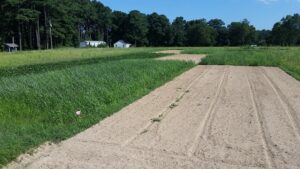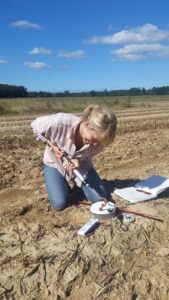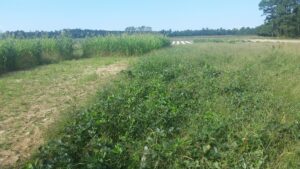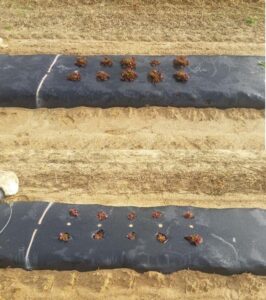Final report for GS16-153
Project Information
Agricultural land management practices influence the physical, chemical, and biological characteristics of soil, including the structure of the community of microorganisms present in the soil, which in turn, directly influences processes such as nutrient cycling and water infiltration and retention, which ultimately shape the long-term health and fertility of an agricultural landscape. The purpose of this study was to examine the effects of cover cropping and tillage practices on the function and structure of soil microbial communities that contribute to soil health. We worked with four farmers in Virginia and conducted studies at the eastern Shore AREC to assess the impact of various practices on the structure and function of the soil microbial communities. Soil samples from field/plots with/without cover crops of varying species (legumes, grasses, brassicas and legume/grass/brassica mixtures) and till/no-till practices were sequenced for microbiome determination. We also examined how cover crops influence soil microbial activity (respiration), N mineralization and fertility, and the performance of the subsequent crop (lettuce). The results of this study generated information on how cover crops, which are becoming increasingly common in the Southern region, influence soil function, and fertility. Legume cover crops increased soil respiration, N mineralization and availability, and performance of the subsequent crop. In contrast, sorghum sudangrass reduced soil respiration, N mineralization and availability, which was reflected in the poor performance of the subsequent crop. The information generated in this study were extended to farmers and peers through field days and conferences presentations for decision making in selecting the appropriate cover crop species. Understanding how cover crops enhance the soil microbial functioning and health, will improve agricultural sustainability.
- To determine how cover crops and tillage practices impact the structure and function of the soil microbial community.
- To determine how cover crops relate to soil characteristics, fertility (i.e. soil organic matter, total carbon and N content, N mineralization rate, and fertility).
- To determine the influence of cover crops on the subsequent cash crop growth and production.
- To disseminate our findings to a wider audience of farmers, researchers, and others in a practical and meaningful way.
Cooperators
Research
The summer cover crop experiment looked at the effects of two types of cover crops on the soil microbial community, soil health, and subsequent crop performance. The experiment involved three treatments – Cowpea, Sorghum Sudan-grass, and no cover crop (control) – replicated three times. The experiment took place at the Eastern Shore Agricultural Research and Extension Center (ESAREC) in Painter, VA. Each plot was 24ft x 65ft. Treatments were arranged in a randomized complete block design. Cover crops were planted on 13 July 2016. The cowpea used was Queen Anne inoculated with Rhizobium at 120lbs/acre and the sorghum Sudan-grass was BMR Sudan Grass F1 OG at 40lbs/acre (Clark, 2008). The field was irrigated using sprinkler irrigation as needed, roughly once a week throughout the summer. The control (no cover crop) plots were maintained by tilling every 3 – 4 weeks. Cover crop stand counts and weed counts were taken 13 days after planting (DAP) using a 1ft x 1ft square (5 per plot). Weeds were also identified at the same time. On 2 Oct. 2016, aboveground biomass samples were taken prior to cover crop incorporation. Weeds and cover crop biomass was determined. A subsample of the dried plant tissue (of both weeds and cover crops) was sent to the laboratory for nutrient analysis.
Cover crops were incorporated on 4 Oct. 2016 by first flail mowing the cover crop to break up the plant residue, rototilling, and then incorporating plant residue with a three-row disc hipper. Following incorporation, soil samples from each plot were taken on October 14th (10 days after incorporation). One sample was frozen and sent out to the Argonne National Laboratory for sequencing and microbial community characterization. One sample was dried and sent out for nutrient analysis. And the last sample was used to conduct the nitrogen (N) mineralization study.
Soil respiration
Soil microbial activity was measured by soil respiration in situ using the method developed by Parkin et al. (1996) using the NRCS Soil Quality Test Kit. A 6-in diameter by 5-in long metal ring was driven into the soil to a depth of 3-in so that the height of the headspace was roughly 2-in. The metal chamber was covered with a plastic lid with two sealed rubber stoppers. After 30 minutes, 100 to 400mL of air, depending on CO2 concentration, was draw out from the chamber through a Draeger CO2 specific tube (RAE Systems, Inc., San Jose, CA) by a RAE pump. In addition, the temperature and volumetric water content (% v/v) were also recorded at depths of 2.5cm and 2.5cm away from the soil respiration chamber. Soil moisture and temperature were taken with a WaterScout SM 100 soil moisture sensor and an external temperature sensor, respectively, connected to WatchDog 1425 data logger (Spectrum Technologies, Inc. Aurora, IL).
Nitrogen mineralization
A 5-week incubation study was conducted in October 2016, roughly two weeks after the soil samples were taken from the field. The purpose of the incubation study was to determine the rate of nitrogen mineralization in an aerobic environment by analyzing the nitrate and ammonia content of the soil at weekly intervals over a 5-week period. At the time of each measurement, the soil samples were extracted with a 2 M KCl solution and run on a Lachat 8500-QuickChem 2000 flow injection autoanalyzer (Lachat Instruments, Loveland, CO) to determine their nitrate and ammonia contents.
Soil samples (20g wet weight) of soil was added to a 250mL plastic jar and weights were monitored. The plastic jars were covered tightly with parafilm. Distilled water was added to bring the soil in the jars to 15% moisture. The weight of the jars was taken each week in order to ensure minimal moisture loss. Moisture loss over the 5 week incubation study was less than 0.25% in all of the jars, therefore no water was added to the jars after the first week. Samples were used for nitrate and ammonia determination at 0, 1, 2, 3, and 5 weeks incubation time in Lachat 8500.
Soil Microbiome
Soil samples from the study at the Eastern Shore AREC and from four farms managed organically and conventionally were used to generate sequencing libraries at the Argonne National Laboratory for microbial community structure. Soil samples taken from farmer’s fields included soil managed with winter cover crops such as hairy vetch, rye, rape, and a mix of rye + vetch, a soil with annual addition of compost, and summer cover crops mixes of sorghum sudangrass + cowpea and sunhemp + millet. Control soil without cover crops were also included. The BIO ESPSF generated Illumina sequencer formatted libraries using DNA and RNA extracted from the soil samples. The BIO ESPSF sequenced the Illumina compatible libraries and provided FASTQ formatted files for each sample sequenced. Output were made available FTP server.
Lettuce production
Red Sail lettuce was planted in each plot on 27 Sept. in order to determine the effects of the cover crop treatments on lettuce yield. The lettuce was planted into black plastic. The lettuce crop was irrigated as needed via drip irrigation. No fertilizer was used in order to determine the fertility effects of the cover crop treatments. Lettuces were harvested on December 19th, 53 DAP. Four lettuce heads were harvested per plot to determine fresh weight, leaf area (LI-COR LI-3100C Area Meter), biomass, and leaf area/biomass ratio. A subsample of the dried lettuce leaf material was sent out to the lab for nutrient analysis. The relationship of growth and production with cover crop and soil fertility was determined. Data was analyzed by ANOVA using SAS 9.4 (SAS Institute Inc., North Carolina).
Dissemination
Information generated from this study was extended to stakeholders and scientific community through presentations at on-farm as well as on-station field days, at growers meetings, and at the SARE “Our Farms, Our Futures” Conference.


Cover Crop Biomass
The average cover crop biomass incorporate into the field by each treatment were significantly different between the cowpea, sorghum sudangrass, and no cover crop (control) treatments. Sorghum sudangrass had the highest average biomass (22.1 ton·ha-1), followed by cowpea (8.1 ton·ha-1), which had the second highest biomass. As expected, the no cover crop treatment provided the least biomass (1.4 ton·ha-1) since those plots were tilled every 3 – 4 weeks to minimize weed growth (Figure 1).
The nitrogen content in the cowpea tissue (3.1%) was significantly higher than that of the sorghum-sudangrass (1.3%), but the nitrogen content of the weeds was not significantly different from the two cover crops. Consequently, the total N contributions of the two cover crop were not significantly different from one another, but significantly greater than that of the no-cover crop control. Specifically, the cowpea cover crop had a total N contribution of 227 kg·ha-1, the sorghum-sudangrass contribution was 286 kg·ha-1, and the no cover crop was 19 kg·ha-1.
Soil fertility
The results of the laboratory soil analysis after cover crop incorporation indicated that, while there were no differences in organic matter (OM) and total organic carbon (TOC) between cover crops, both parameters increased when compared to the no-cover crop control. Similarly, there were no differences in total Nitrogen and C/N ratio among all three treatments. In contrast, extractable nitrate (NO3-N) was significantly different between all three treatments. Cowpea was highest in nitrate (9.3 ppm), followed by the no-cover crop control (4.7 ppm). Extractable nitrate was significantly less after Sorghum sudangrass (1.0 ppm) than the other cover crops. In addition, both cover crop treatments were significantly higher than the no cover crop control in both Potassium (K) and Magnesium (Mg), however the differences between the Potassium and Magnesium contents of the two cover crop treatments was not significant. There was no significant difference in Phosphorous (P) and Calcium (Ca) contents between the three treatments.
Soil Respiration
The average soil respiration rate of the cowpea treatment (314 kg∙ha-1∙d-1 CO2) was significantly higher than that of the no cover crop control (100 kg∙ha-1∙d-1 CO2). The average soil respiration rate of the sorghum sudangrass treatment (277 kg∙ha-1∙d-1 CO2) was between the Cowpea and the control treatment and did not differ significantly from them. This suggest that legume cover crops promote microbial activity immediately after incorporation, but sorghum sudangrass somehow inhibit microbial activity in the short term.
Nitrogen mineralization
The rate of N mineralization was determined by analyzing the extractable nitrate and ammonia content of the soil incubated in an aerobic environment. The results show significant differences between the three treatments in the extractable nitrate at weeks 1, 2, 3, and 5. Cowpea increased from 0.5 ppm extractable nitrate to 2.4 ppm extractable nitrate after 5 weeks and was significantly larger than the other two treatments from weeks 1 through 5. Nitrate concentration in Sorghum-sudangrass and no-cover control without cover crop increased to 0.9 and 1.1 ppm, respectively, after week 5. However, Sorghum sudangrass was less than the no-cover control treatments in weeks 1 and 2. The ammonia concentration, however, was variable throughout the 5-week study and no significant differences were found between the three treatments. Extracted ammonia ranged between 0.04 and 0.08 ppm in all five weeks of the incubation study. These results are in agreement with the soil respiration and the soil fertility results suggesting that legume cover crops promote microbial activity immediately after incorporation, but sorghum sudangrass somehow inhibit microbial activity in the short term.
Soil microbiome.
The Argonne National Laboratory, the BIO ESPSF generated Illumina sequencer formatted libraries from the DNA and RNA extracted from the soil samples, and provided FASTQ formatted files for each sample sequenced. Output were made available at the FTP server. Processing and analysis of the sequence data is in progress, which is expected to determine differences in microbiome structure among the cover crop species. In addition, the association of microbial communities with soil characteristics and function is expected.
Lettuce production
Plant fresh weight was significantly higher for lettuces that followed the cowpea cover crop (39 g) and no cover crop (39 g) than those that followed the sorghum sudangrass cover crop (6 g). There were no differences between cowpea and no cover crop. Similarly, leaf area was superior in cowpea (610 cm2) and no cover crop (658 cm2) than Sorghum sudangrass (136 cm2). These results may be explained partially by the reduced nitrate-nitrogen available after incorporation of Sorghum sudangrass. In addition, results support the idea that legume cover crops promote microbial activity and N mineralization immediately after incorporation, but sorghum sudangrass somehow inhibit microbial activity and N mineralization in the short term.


Educational & Outreach Activities
Participation Summary:
Cover-crops-UMES2017-Arancibia
Major Report
Taggart, S.P. 2017. Living Soil for a Sustainable Future: Cover Crop Effects on Soil Health and Productivity. Project Report submitted to the faculty of the Virginia Polytechnic Institute and State University in partial fulfillment of the requirements for the degree of Online Masters of Agricultural and Life Sciences In Plant Science & Pest Management. https://vtechworks.lib.vt.edu/handle/10919/51287/browse?type=author&value=Taggart%2C+Samantha+P.
On-farm studies where soil samples were taken:
- Blenheim Organic Gardens, Westmoreland County, VA.
- Lois’s Produce in Westmoreland Co., VA.
- Quail Cove farm in NorthHampton Co.
- Copper Cricket Farm in NorthHampton Co.
Conference presentations
- Arancibia, R.A. 2017. How to manage cover cropping for small producers. 14th Annual Small Farm Conference. University of Maryland Eastern Shore. November 3-4, 2017. Princess Anne, MD. Participants: 21
- Taggart and Arancibia. 2018. Living Soil for a Sustainable Future: Cover Crop Effects on Soil Health and Productivity. SARE “Our Farms, Our Futures” Conference. April 3–5, 2018, St. Louis, Missouri.
- Taggart, Reiter, and Arancibia. 2018. Living Soil for a Sustainable Future: Cover Crop Effects on Soil Health and Productivity. ASHS Annual Conference. 31 July-3 August, Washington, DC.
Field days/tours
- Arancibia, R.A. 2017. Cover crops management. Eastern Shore AREC tour, 7th National Small Farm Conference. Sept. 21, 2016. Eastern Shore AREC, Painter, VA. Participants: 30
- Arancibia, R.A. 2017. Cover crops management. Eastern Shore AREC tour for young farmers from Bedford County, VA. Aug.13, 2016. Eastern Shore AREC, Painter, VA. Participants: 21
- Reiter and Arancibia, 2017. Eastern Virginia Cover Crop In-Service Training & Team-Building Event. April 24 and 25, 2017, Eastern Shore AREC. Painter, VA. Participants: 95
- Arancibia, R.A. 2018. Cover crop management. On-Farm Twilight Vegetable Growers Meetings. August 27, 2018. The Farm at Sunnyside, Washington, VA. Participants: 52
Project Outcomes
This project generated and disseminated information about cover crops management and their influence on soil health, fertility, microbial activity (respiration and nitrogen mineralization) and subsequent crop (lettuce) performance. Differences in soil microbial activity, N mineralization and availability among cover crop species suggest that cover crops can promote or inhibit microbial activity and soil fertility. Therefore, cover crop species are expected to influence the soil microbiome structure. From the production point of view, an economic advantage was demonstrated with legume cover cropss due to N fixation and fast mineralization after incorporation. In contrast, Sorghum sudangrass may improve recycling of soil nutrients and avoid losses by deep percolation beyond the reach of the root system, but the subsequent crop may have a poor performance. This suggest that it should be used in mixes and the subsequent cash crop requires fertilization. Therefore, an increase in economic sustainability is expected by understanding and adopting rotations with cover crops in vegetable crops production. Similarly, the environmental sustainability is expected to improve with the appropriate cover crops and mixes mainly by the following:
- Reduction in Nitrogen fertilizer used.
- Reduction in nutrient leaching due to the microbiome nutrient uptake.
- Reduction in soil erosion due to cover crops.
Food supply and security are key problems of regional, national and international importance. Strengthening the production capacity of specialty crop farmers is expected to increase supply of locally grown fresh and healthy food, and reduce the dependency on distant production areas, therefore, increasing food security in local markets. Therefore, this project is expected to enhance the quality of life of farmers, farm workers and society as a whole.
I have always been a proponent of sustainable agriculture but had never really conducted any controlled, scientific research on the methods and practices employed in sustainable agriculture up until the start of this project. My knowledge and skills base of the intricacies and challenges of collecting valid, useful data, particularly in such a multifaceted study as ours, was increased dramatically through the course of this project. My advisor, on the other hand, has conducted research in the sustainable agriculture field for many years and is a strong advocate for increasing the efficacy and impact of using sustainable methods in agricultural production.
From the get-go our project was designed to be as grower-focused as possible, which is why we incorporated a measurement of cash crop growth and production into the study. Through the course of talking to farmers and other agricultural research specialists, it became apparent that one of the key goals in sustainable agricultural research must be to demonstrate to farmers, through the use of concrete and robust data, that sustainable agricultural methods and technologies will benefit them from both an environmental and economic standpoint. Our project demonstrates the productive and environmental benefits derived from using cover crops as well as other sustainable agriculture production technologies to enhance soil health and crop yield in the production of vegetable crops. Our project also highlighted the need for further study into the relationships between cover crops, soil microbiology and long-term soil health, and vegetable crop production in the field of sustainable agriculture.
Based on the results of this study, we conclude that using cowpea as a summer cover crop has the potential to significantly increase available soil nitrogen and improve the production of a fall lettuce crop. Cover crops have been shown to enhance soil health and productivity, but the inhibition of soil microbial activity, N mineralization and availability, and poor crop performance after sorghum sudangrass suggest that microbiome and soil function is influenced by the cover crop species. In the case of grass cover crops, additional fertilization is needed for the subsequent cash crop. Therefore, incorporating cover crops into vegetable crop rotations is recommended to improve sustainability, but selection and management of the cover crop species is critical.